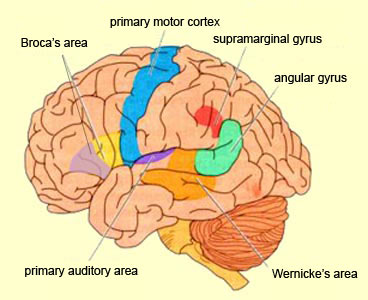Angular gyrus
From Psy3241
Association with Language
The angular gyrus is a region of cortex on the temporal/parietal border and is known for its importance in the comprehension of visually presented materials (Stirling, 2002). The discovery of this area contributed to the notion of a “localization of function” within the brain, a very novel idea at the time (Stirling, 2002). In 1892, Dejerine, around the same time Broca's area and Wernicke's area were discovered as language areas of the brain, determined that this structure was related to alexia, or an inability to read. Patients with damage to the angular gyrus demonstrated receptive language problems, due to the fact that the angular gyrus is in some way connected to Wernicke’s area. Therefore, this area is considered part of a distributed cortical network involved in the full range of human lingual abilities.
Current views of the language system include three parts, the language implementation system, the mediational system, and the conceptual system. Kandel, Schwartz, and Jessell (2000) conclude that the angular gyrus functions in the implementation system, which is composed of many regions around the sylvian fissure. This part of the system is believed to analyze incoming auditory stimuli in order to activate conceptual knowledge, ensure phonemic and grammatical construction, and provide control of articulation of the mouth and tongue.
Damage
In Ramachandran’s book Phantoms in the Brain, he explains a patient by the name of Bill, who suffered a stroke in the left angular gyrus. He suffered deficits in his calculating abilities, called dyscalculia, and could not even subtract 7 from 100. He also demonstrated finger agnosia, meaning he could not name which of his fingers that the neurologist was pointing to or touching. (Ramachandran notes that these two abilities are dissociable; they do not always coexist in damage to this area and may exist separately as well) Ramachandran (1998) relays that this area of the brain is somehow necessary for numerical computational tasks, although, oddly, it is not needed for understanding the numerical concepts that underlie such calculations. He also notes that the patient Bill had normal short-term memory and humor, indicating that this structure is not necessary for these functions.
Ramachandran (1998) also describes a young child named Nadia, who at the mere age of five was completing drawings of horses comparable to the works of DaVinci! Although the girl suffered from severe autism and had an IQ score between 60 and 70, she had a seemingly innate mathematical ability that allowed her to calculate prime numbers with astonishing skill. Interestingly, the author questions whether or not this girl could have gained a hypertrophied left angular gyrus as the result of compensational developmental plasticity. He also notes a lateral difference in the functions of the angular gyrus: damage to the right side disrupts artistic skills, while damage to the left side disrupts calculation.
References
Stirling, J. (2002). Introducing Neuropsychology. New York: Psychology Press.
Ramachandran, V. S. & Blakeslee, S. (1998). Phantoms in the Brain. New York: HarperCollins Publishers.
Kandel, E. R., Schwartz, J. H. & Jessell, T. M. (2000). Principles of Neural Science (4th ed.).New York: McGraw Hill.
Image taken from: 

